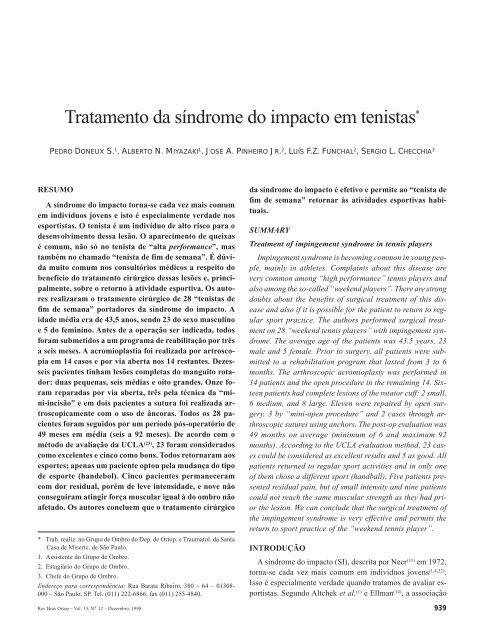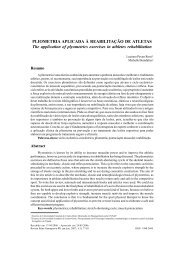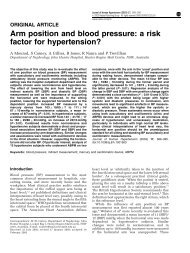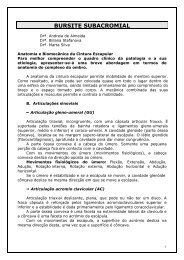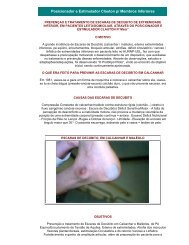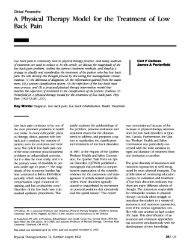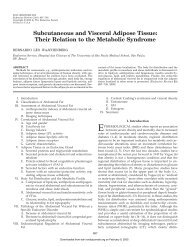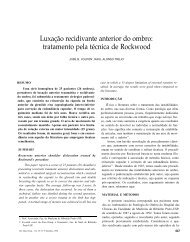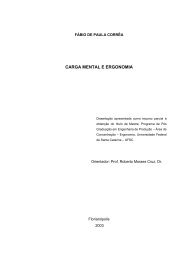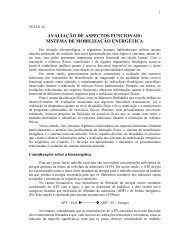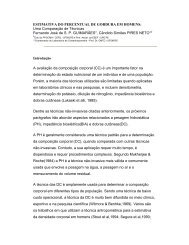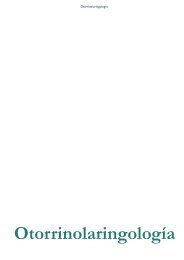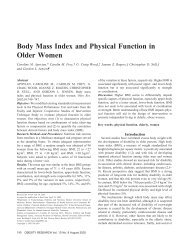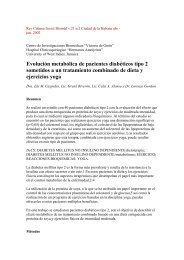Tratamento da sÃndrome do impacto em tenistas* - Portal Saude ...
Tratamento da sÃndrome do impacto em tenistas* - Portal Saude ...
Tratamento da sÃndrome do impacto em tenistas* - Portal Saude ...
Create successful ePaper yourself
Turn your PDF publications into a flip-book with our unique Google optimized e-Paper software.
TRATAMENTO DA SÍNDROME DO IMPACTO EM TENISTAS<br />
<strong>Tratamento</strong> <strong>da</strong> síndrome <strong>do</strong> <strong>impacto</strong> <strong>em</strong> tenistas *<br />
PEDRO DONEUX S. 1 , ALBERTO N. MIYAZAKI 1 , JOSÉ A. PINHEIRO JR. 2 , LUÍS F.Z. FUNCHAL 2 , SERGIO L. CHECCHIA 3<br />
RESUMO<br />
A síndrome <strong>do</strong> <strong>impacto</strong> torna-se ca<strong>da</strong> vez mais comum<br />
<strong>em</strong> indivíduos jovens e isto é especialmente ver<strong>da</strong>de nos<br />
esportistas. O tenista é um indivíduo de alto risco para o<br />
desenvolvimento dessa lesão. O aparecimento de queixas<br />
é comum, não só no tenista de “alta performance”, mas<br />
também no chama<strong>do</strong> “tenista de fim de s<strong>em</strong>ana”. É dúvi<strong>da</strong><br />
muito comum nos consultórios médicos a respeito <strong>do</strong><br />
benefício <strong>do</strong> tratamento cirúrgico dessas lesões e, principalmente,<br />
sobre o retorno à ativi<strong>da</strong>de esportiva. Os autores<br />
realizaram o tratamento cirúrgico de 28 “tenistas de<br />
fim de s<strong>em</strong>ana” porta<strong>do</strong>res <strong>da</strong> síndrome <strong>do</strong> <strong>impacto</strong>. A<br />
i<strong>da</strong>de média era de 43,5 anos, sen<strong>do</strong> 23 <strong>do</strong> sexo masculino<br />
e 5 <strong>do</strong> f<strong>em</strong>inino. Antes de a operação ser indica<strong>da</strong>, to<strong>do</strong>s<br />
foram submeti<strong>do</strong>s a um programa de reabilitação por três<br />
a seis meses. A acromioplastia foi realiza<strong>da</strong> por artroscopia<br />
<strong>em</strong> 14 casos e por via aberta nos 14 restantes. Dezesseis<br />
pacientes tinham lesões completas <strong>do</strong> manguito rota<strong>do</strong>r:<br />
duas pequenas, seis médias e oito grandes. Onze foram<br />
repara<strong>da</strong>s por via aberta, três pela técnica <strong>da</strong> “mini-incisão”<br />
e <strong>em</strong> <strong>do</strong>is pacientes a sutura foi realiza<strong>da</strong> artroscopicamente<br />
com o uso de âncoras. To<strong>do</strong>s os 28 pacientes<br />
foram segui<strong>do</strong>s por um perío<strong>do</strong> pós-operatório de<br />
49 meses <strong>em</strong> média (seis a 92 meses). De acor<strong>do</strong> com o<br />
méto<strong>do</strong> de avaliação <strong>da</strong> UCLA (23) , 23 foram considera<strong>do</strong>s<br />
como excelentes e cinco como bons. To<strong>do</strong>s retornaram aos<br />
esportes; apenas um paciente optou pela mu<strong>da</strong>nça <strong>do</strong> tipo<br />
de esporte (handebol). Cinco pacientes permaneceram<br />
com <strong>do</strong>r residual, porém de leve intensi<strong>da</strong>de, e nove não<br />
conseguiram atingir força muscular igual à <strong>do</strong> ombro não<br />
afeta<strong>do</strong>. Os autores conclu<strong>em</strong> que o tratamento cirúrgico<br />
* Trab. realiz. no Grupo de Ombro <strong>do</strong> Dep. de Ortop. e Traumatol. <strong>da</strong> Santa<br />
Casa de Miseric. de São Paulo.<br />
1. Assistente <strong>do</strong> Grupo de Ombro.<br />
2. Estagiário <strong>do</strong> Grupo de Ombro.<br />
3. Chefe <strong>do</strong> Grupo de Ombro.<br />
Endereço para correspondência: Rua Barata Ribeiro, 380 – 64 – 01308-<br />
000 – São Paulo, SP. Tel. (011) 222-6866, fax (011) 255-4840.<br />
<strong>da</strong> síndrome <strong>do</strong> <strong>impacto</strong> é efetivo e permite ao “tenista de<br />
fim de s<strong>em</strong>ana” retornar às ativi<strong>da</strong>des esportivas habituais.<br />
SUMMARY<br />
Treatment of imping<strong>em</strong>ent syndrome in tennis players<br />
Imping<strong>em</strong>ent syndrome is becoming common in young people,<br />
mainly in athletes. Complaints about this disease are<br />
very common among “high performance” tennis players and<br />
also among the so-called “weekend players”. There are strong<br />
<strong>do</strong>ubts about the benefits of surgical treatment of this disease<br />
and also if it is possible for the patient to return to regular<br />
sport practice. The authors performed surgical treatment<br />
on 28 “weekend tennis players” with imping<strong>em</strong>ent syndrome.<br />
The average age of the patients was 43.5 years, 23<br />
male and 5 f<strong>em</strong>ale. Prior to surgery, all patients were submitted<br />
to a rehabilitation program that lasted from 3 to 6<br />
months. The arthroscopic acromioplasty was performed in<br />
14 patients and the open procedure in the r<strong>em</strong>aining 14. Sixteen<br />
patients had complete lesions of the rotator cuff: 2 small,<br />
6 medium, and 8 large. Eleven were repaired by open surgery,<br />
3 by “mini-open procedure” and 2 cases through arthroscopic<br />
sutures using anchors. The post-op evaluation was<br />
49 months on average (minimum of 6 and maximum 92<br />
months). According to the UCLA evaluation method, 23 cases<br />
could be considered as excellent results and 5 as good. All<br />
patients returned to regular sport activities and in only one<br />
of th<strong>em</strong> chose a different sport (handball). Five patients presented<br />
residual pain, but of small intensity and nine patients<br />
could not reach the same muscular strength as they had prior<br />
the lesion. We can conclude that the surgical treatment of<br />
the imping<strong>em</strong>ent syndrome is very effective and permits the<br />
return to sport practice of the “weekend tennis player”.<br />
INTRODUÇÃO<br />
A síndrome <strong>do</strong> <strong>impacto</strong> (SI), descrita por Neer (31) <strong>em</strong> 1972,<br />
torna-se ca<strong>da</strong> vez mais comum <strong>em</strong> indivíduos jovens (1,4,22) .<br />
Isso é especialmente ver<strong>da</strong>de quan<strong>do</strong> tratamos de avaliar esportistas.<br />
Segun<strong>do</strong> Altchek et al. (1) e Ellman (14) , a associação<br />
Rev Bras Ortop _ Vol. 33, Nº 12 – Dez<strong>em</strong>bro, 1998 939
P. DONEUX S., A.N. MIYAZAKI, J.A. PINHEIRO JR., L.F.Z. FUNCHAL & S.L. CHECCHIA<br />
de lesão <strong>do</strong> manguito rota<strong>do</strong>r (LMR) com ativi<strong>da</strong>de esportiva<br />
não é incomum.<br />
Várias seriam as causas <strong>do</strong> aparecimento dessa lesão nessa<br />
população, associa<strong>da</strong>s ao processo isquêmico natural conheci<strong>do</strong><br />
como “área crítica” <strong>do</strong> tendão <strong>do</strong> músculo supraespinhal<br />
(manguito rota<strong>do</strong>r) (31,35,44) .<br />
O atleta de m<strong>em</strong>bro superior e, com certeza, o tenista, é<br />
um indivíduo de risco para o desenvolvimento dessas lesões<br />
(1,22,34,36) . O ombro <strong>do</strong>loroso afeta não só o atleta de alta<br />
performance, associa<strong>do</strong> com o over use (1,22,34) , como também<br />
o assim chama<strong>do</strong> “atleta de fim de s<strong>em</strong>ana”, como observa<strong>do</strong><br />
por Richardson et al. (36) <strong>em</strong> seus trabalhos de análise de<br />
<strong>do</strong>r <strong>em</strong> ombro de atletas de alta performance <strong>em</strong> comparação<br />
com esportistas de fim de s<strong>em</strong>ana.<br />
É muito freqüente questionar, nos consultórios médicos, o<br />
benefício <strong>do</strong> tratamento cirúrgico dessas lesões, principalmente<br />
quanto ao retorno às ativi<strong>da</strong>des esportivas.<br />
Nosso trabalho avalia o resulta<strong>do</strong> <strong>do</strong> tratamento cirúrgico<br />
dessas lesões, no chama<strong>do</strong> “tenista de fim de s<strong>em</strong>ana”, e correlaciona<br />
o benefício <strong>do</strong> tratamento cirúrgico <strong>em</strong> relação ao<br />
retorno às ativi<strong>da</strong>des esportivas.<br />
CASUÍSTICA E MÉTODO<br />
Realizamos o tratamento cirúrgico de 28 tenistas porta<strong>do</strong>res<br />
de SI, com ou s<strong>em</strong> LMR completa.<br />
Nenhum <strong>do</strong>s pacientes incluí<strong>do</strong>s nesta casuística era atleta<br />
profissional.<br />
A i<strong>da</strong>de média <strong>do</strong>s pacientes foi de 43,5 anos (25 a 62<br />
anos). Separan<strong>do</strong> os pacientes com LMR completas, <strong>da</strong>s incompletas,<br />
as i<strong>da</strong>des médias foram de 48,8 anos e de 40,5<br />
anos, respectivamente. Vinte e três eram <strong>do</strong> sexo masculino<br />
(82,1%) e 5 <strong>do</strong> f<strong>em</strong>inino (17,9%). O m<strong>em</strong>bro <strong>do</strong>minante foi<br />
opera<strong>do</strong> <strong>em</strong> 25 pacientes (tabela 1).<br />
TABELA 1<br />
Nº I<strong>da</strong>de Sexo Dominância Lesão LMR <strong>Tratamento</strong> Seguimento UCLA Prática tênis/s<strong>em</strong>.<br />
(anos)<br />
associa<strong>da</strong><br />
Pré Pós<br />
1 39 M Sim – Média Aberto 2a 10m 35 2 2<br />
2 42 M Sim – Média Aberto 3a 10m 35 4 4<br />
3 46 F Não – Incompleta Artroscópico 2a 19m 35 3 3<br />
4 46 F Sim – Incompleta Artroscópico 2a 19m 35 4 3<br />
5 53 M Sim – Grande Aberto 7a 13m 34 3 4<br />
6 28 F Sim Instabili<strong>da</strong>de Incompleta Aberto 4a 11m 35 3 3<br />
7 39 M Sim – Grande Aberto 3a 12m 33 2 2<br />
8 43 M Sim – Grande Aberto 3a 10m 34 3 2<br />
9 56 M Sim – Média “Mini-incisão” 2a 15m 34 2 2<br />
10 25 M Sim Instabili<strong>da</strong>de Incompleta Aberto 2a 14m 35 2 2<br />
11 37 F Não – Incompleta Artroscópico 2a 11m 35 2 2<br />
12 59 M Sim – Grande Aberto 6a 10m 34 2 2<br />
13 51 M Sim Bíceps Média Aberto 2a 10m 35 3 3<br />
14 47 M Sim Capsulite Incompleta Artroscópico 1a 15m 35 4 3<br />
15 44 M Sim – Incompleta Artroscópico 1a 19m 33 4 3<br />
16 25 M Sim – Grande “Mini-incisão” 1a 17m 34 3 3<br />
17 59 M Sim – Grande Aberto 1a 18m 32 2 2<br />
18 58 M Sim – Pequena Artroscópico 1a 14m 35 4 3<br />
19 43 M Sim – Incompleta Artroscópico 1a 11m 35 2 2<br />
20 57 M Sim – Média “Mini-incisão” 1a 10m 35 3 3<br />
21 36 M Sim – Incompleta Artroscópico 1a 16m 33 4 3<br />
22 40 M Sim Artrose Incompleta Artroscópico 1a 14m 31 4 3<br />
23 38 M Sim – Média Aberto 6a 18m 35 3 2<br />
24 62 M Sim – Grande Aberto 2a 18m 34 3 3<br />
25 50 M Sim – Incompleta Aberto 7a 18m 35 4 4<br />
26 41 F Não SLAP II Incompleta Artroscópico 1a 11m 35 4 4<br />
27 44 M Sim SLAP I Pequena Artroscópico 1a 15m 35 3 3<br />
28 52 M Sim – Grande Aberto 1a 18m 33 3 3<br />
M – masculino; F – f<strong>em</strong>inino; LMR – lesão <strong>do</strong> manguito rota<strong>do</strong>r; a – anos; m – meses; s<strong>em</strong> – s<strong>em</strong>ana.<br />
940 Rev Bras Ortop _ Vol. 33, Nº 12 – Dez<strong>em</strong>bro, 1998
TRATAMENTO DA SÍNDROME DO IMPACTO EM TENISTAS<br />
Fig. 1A – Visão artroscópica de uma<br />
lesão completa <strong>do</strong> manguito rota<strong>do</strong>r,<br />
comprometen<strong>do</strong> o tendão <strong>do</strong> músculo<br />
supra-espinhal, ombro direito<br />
Fig. 1C – Fio de sutura inabsorvível<br />
nº 2 passa<strong>do</strong> pela bor<strong>da</strong> <strong>da</strong> lesão,<br />
com o auxílio de âncora<br />
transóssea<br />
Fig. 1B – Visão subacromial<br />
<strong>da</strong> mesma lesão<br />
Fig. 1D – Sutura realiza<strong>da</strong> com<br />
<strong>do</strong>is pontos artroscópicos<br />
Fig. 1E – Radiografia mostran<strong>do</strong> a<br />
colocação <strong>da</strong>s âncoras ósseas<br />
To<strong>do</strong>s eram “tenistas de fim de s<strong>em</strong>ana” e assim o foram<br />
considera<strong>do</strong>s desde que praticass<strong>em</strong> o esporte pelo menos<br />
duas a quatro vezes por s<strong>em</strong>ana. Seis pacientes, além <strong>do</strong> tênis,<br />
praticavam regularmente outros esportes que utilizam<br />
os m<strong>em</strong>bros superiores: três natação, um squash, um capoeira<br />
e um handebol.<br />
O t<strong>em</strong>po de <strong>do</strong>r entre o início <strong>da</strong> <strong>do</strong>ença e a operação foi,<br />
na mediana, de 63 meses (6 a 120 meses). Antes de a operação<br />
ser indica<strong>da</strong>, to<strong>do</strong>s os pacientes foram submeti<strong>do</strong>s a um<br />
programa de reabilitação por três a seis meses (6) .<br />
To<strong>do</strong>s os casos foram avalia<strong>do</strong>s, pré-operatoriamente, com<br />
no mínimo cinco incidências radiográficas: frente corrigi<strong>do</strong><br />
(27) , perfil <strong>da</strong> escápula (perfil <strong>do</strong> acrômio) (28) , axilar (43) , Zanca<br />
(46) e Rockwood (38) . Em alguns casos, quan<strong>do</strong> possível, foram<br />
realiza<strong>da</strong>s a ultra-sonografia e/ou a imag<strong>em</strong> de ressonância<br />
magnética.<br />
A acromioplastia foi realiza<strong>da</strong> por artroscopia <strong>em</strong> 14 casos<br />
e por via aberta nos 14 restantes (31,39) .<br />
Dezesseis pacientes eram porta<strong>do</strong>res de LMR completas,<br />
sen<strong>do</strong> duas pequenas, seis médias e oito grandes, de acor<strong>do</strong><br />
com a classificação proposta por Cofield (10) . Onze lesões fo-<br />
ram repara<strong>da</strong>s por via aberta (2,5,9) , três pela técnica <strong>da</strong> “mini-incisão”<br />
(3,17,33) e <strong>em</strong> <strong>do</strong>is casos a sutura foi realiza<strong>da</strong> artroscopicamente<br />
com o uso de âncoras (42) (figura 1 – A, B, C,<br />
D e F). Dos pacientes com LMR incompletas, nove foram<br />
trata<strong>da</strong>s artroscopicamente e três por via aberta (tabela 1).<br />
Quatro pacientes tinham, pré-operatoriamente, <strong>do</strong>r na articulação<br />
acromioclavicular e foram submeti<strong>do</strong>s à ressecção<br />
<strong>da</strong> clavícula distal (procedimento de Munford), sen<strong>do</strong> <strong>do</strong>is<br />
por via artroscópica (42) e <strong>do</strong>is por via aberta (29) .<br />
Quatro pacientes tinham, além <strong>da</strong> SI, a associação de outras<br />
lesões:<br />
• <strong>do</strong>is casos de SLAP lesion (42) , sen<strong>do</strong> um <strong>do</strong> tipo I e um<br />
<strong>do</strong> tipo II, e ambas foram trata<strong>da</strong>s com desbri<strong>da</strong>mento artroscópico<br />
(pacientes 26 e 27).<br />
• um paciente tinha uma artrose <strong>da</strong> articulação glenoumeral<br />
trata<strong>da</strong> com desbri<strong>da</strong>mento artroscópico (paciente 22).<br />
• um caso tinha uma capsulite adesiva, sen<strong>do</strong> trata<strong>do</strong> com<br />
manipulação articular, no mesmo ato operatório (11,13) (paciente<br />
14).<br />
Apenas um paciente apresentava SI por instabili<strong>da</strong>de articular,<br />
sen<strong>do</strong> trata<strong>do</strong> com capsuloplastia (32) e a acromioplastia<br />
realiza<strong>da</strong> pela via deltopeitoral (paciente 10).<br />
Rev Bras Ortop _ Vol. 33, Nº 12 – Dez<strong>em</strong>bro, 1998 941
P. DONEUX S., A.N. MIYAZAKI, J.A. PINHEIRO JR., L.F.Z. FUNCHAL & S.L. CHECCHIA<br />
O sist<strong>em</strong>a de avaliação escolhi<strong>do</strong> foi o <strong>da</strong> UCLA (University<br />
of California at Los Angeles) (23) . O retorno à prática esportiva,<br />
com a mesma freqüência que antes <strong>do</strong> início <strong>da</strong> incapaci<strong>da</strong>de,<br />
ou a eventual modificação <strong>do</strong> tipo de esporte,<br />
foi também considera<strong>do</strong> como importante na avaliação <strong>do</strong>s<br />
resulta<strong>do</strong>s.<br />
O méto<strong>do</strong> estatístico utiliza<strong>do</strong> foi o <strong>do</strong> qui-quadra<strong>do</strong> (*) .<br />
RESULTADOS<br />
To<strong>do</strong>s os 28 pacientes foram segui<strong>do</strong>s por um perío<strong>do</strong> pósoperatório<br />
de 49 meses <strong>em</strong> média (seis a 92 meses).<br />
De acor<strong>do</strong> com o méto<strong>do</strong> <strong>da</strong> UCLA (23) , 23 pacientes obtiveram<br />
resulta<strong>do</strong>s considera<strong>do</strong>s excelentes e cinco, bons; portanto,<br />
os 28 pacientes obtiveram resulta<strong>do</strong>s satisfatórios (tabela<br />
1).<br />
To<strong>do</strong>s retornaram aos esportes; apenas um paciente optou<br />
pela mu<strong>da</strong>nça <strong>do</strong> tipo de esporte, passan<strong>do</strong> à prática de handebol<br />
(paciente 10). Cinco pacientes permaneceram com <strong>do</strong>r<br />
residual, porém de leve intensi<strong>da</strong>de (pacientes 7, 15, 17, 21 e<br />
22). Outros nove pacientes não conseguiram atingir força<br />
muscular igual à <strong>do</strong> ombro não afeta<strong>do</strong> (pacientes 5, 7, 8, 9,<br />
12, 16, 17, 24 e 28).<br />
Não tiv<strong>em</strong>os nenhuma complicação, tanto intra como pósoperatória.<br />
DISCUSSÃO<br />
Encontramos pre<strong>do</strong>minância importante de acometimento<br />
<strong>do</strong> m<strong>em</strong>bro <strong>do</strong>minante; 25 ombros <strong>do</strong>minantes para três<br />
não <strong>do</strong>minantes. Convém ressaltar que esses três pacientes<br />
praticavam, além <strong>do</strong> tênis, outras mo<strong>da</strong>li<strong>da</strong>des esportivas que<br />
utilizam os <strong>do</strong>is m<strong>em</strong>bros superiores: natação, handebol e<br />
musculação (pacientes 3, 10 e 21).<br />
Analisan<strong>do</strong> separa<strong>da</strong>mente a i<strong>da</strong>de média <strong>do</strong>s pacientes<br />
que tinham lesões completas <strong>do</strong>s tendões <strong>do</strong> manguito rota<strong>do</strong>r<br />
e a <strong>da</strong>queles que tinham lesões incompletas, verificamos<br />
diferença de 48,8 para 40,5 anos de i<strong>da</strong>de, que, provavelmente,<br />
poderia ser explica<strong>da</strong>, pois a LMR é uma evolução<br />
<strong>da</strong> SI quan<strong>do</strong> não trata<strong>da</strong> (45) .<br />
Comparan<strong>do</strong>-se a i<strong>da</strong>de média <strong>do</strong>s pacientes esportistas<br />
com lesões completas <strong>do</strong> manguito rota<strong>do</strong>r com a de pacientes<br />
não esportistas com lesões completas e também trata<strong>do</strong>s<br />
(*) Guedes, M.L.S. & Guedes, J.S.: Bioestatística para profissionais de saúde,<br />
Rio de Janeiro, Ao Livro Técnico S/A, 1988.<br />
por nós (6,8) , verifica-se diferença de i<strong>da</strong>de de 48,8 para 57<br />
anos. Quan<strong>do</strong> compara<strong>da</strong>s as i<strong>da</strong>des <strong>do</strong>s pacientes esportistas<br />
e não esportistas (6,8) , com lesões incompletas <strong>do</strong> manguito<br />
rota<strong>do</strong>r, verifica-se diferença de i<strong>da</strong>de de 40,5 para 44 anos.<br />
Embora essas diferenças sejam observa<strong>da</strong>s e eventualmente<br />
explica<strong>da</strong>s pelo over use (1,22) , não pud<strong>em</strong>os confirmá-las pelo<br />
méto<strong>do</strong> estatístico utiliza<strong>do</strong>.<br />
Quanto ao tratamento cirúrgico realiza<strong>do</strong>, verificamos que<br />
três pacientes com LMR incompletas foram trata<strong>do</strong>s por via<br />
aberta. Destes, <strong>do</strong>is não foram trata<strong>do</strong>s por artroscopia por<br />
ser casos opera<strong>do</strong>s, <strong>em</strong> média, há sete anos e, na época, não<br />
tínhamos o conhecimento adequa<strong>do</strong> desta técnica (pacientes<br />
6 e 25); <strong>em</strong> outro (paciente 10) a acromioplastia foi feita<br />
pela própria via deltopeitoral quan<strong>do</strong> <strong>da</strong> realização <strong>da</strong> capsuloplastia.<br />
A artroscopia é o méto<strong>do</strong> de eleição para esses casos, pois<br />
permite recuperação mais rápi<strong>da</strong> e com menor morbi<strong>da</strong>de (12,<br />
14-16,18,20,24-26,40,41)<br />
. Mesmo nos pacientes <strong>em</strong> que há LMR completa,<br />
desde que a lesão não seja grande e retraí<strong>da</strong>, é possível<br />
o uso <strong>da</strong> artroscopia, pois pod<strong>em</strong>os realizar a descompressão<br />
subacromial artroscópica e a LMR pode ser trata<strong>da</strong> pela técnica<br />
<strong>da</strong> “mini-incisão” (3,17,33) ou mesmo pela sutura artroscópica<br />
(42) (pacientes 9, 16, 18, 20 e 27).<br />
Pod<strong>em</strong>os notar que, <strong>do</strong>s 16 casos de LMR completa, nove<br />
evoluíram com diminuição <strong>da</strong> força muscular; destes, oito<br />
tinham LMR classifica<strong>da</strong>s como grandes e apenas um, LMR<br />
média. Esse fato é freqüent<strong>em</strong>ente cita<strong>do</strong> na literatura (19) ; raramente<br />
uma LMR completa grande, mesmo que repara<strong>da</strong>,<br />
evolui com força normal, pois a degeneração gordurosa <strong>da</strong>s<br />
fibras musculares é definitiva (7,21,30) . Diferent<strong>em</strong>ente, <strong>do</strong>s oito<br />
pacientes que tinham lesões considera<strong>da</strong>s pequenas ou médias,<br />
apenas um evoluiu com diminuição <strong>da</strong> força muscular<br />
(paciente 9). Isso pode ser explica<strong>do</strong> pelo melhor prognóstico<br />
<strong>da</strong> manutenção <strong>da</strong> sutura dessas lesões. Obviamente, podese<br />
criticar o méto<strong>do</strong> manual de avaliação <strong>da</strong> força muscular,<br />
pois há grande variação de interpretação <strong>do</strong> que seja força<br />
subnormal (37) . Entretanto, nenhum <strong>do</strong>s pacientes se queixou,<br />
quan<strong>do</strong> <strong>da</strong> avaliação final, de per<strong>da</strong> de força significativa<br />
que dificultasse o retorno à prática <strong>do</strong> tênis.<br />
Interessante é verificar que, <strong>do</strong>s oito casos de LMR considera<strong>da</strong>s<br />
grandes, apenas <strong>do</strong>is queixavam-se de <strong>do</strong>r residual<br />
leve e, <strong>do</strong>s 12 pacientes com LMR incompletas, três tinham<br />
essa mesma queixa. Dev<strong>em</strong>os ressaltar que esses cinco pacientes,<br />
apesar <strong>da</strong> <strong>do</strong>r, retornaram normalmente à prática esportiva.<br />
Apenas um paciente, de 25 anos de i<strong>da</strong>de, modificou sua<br />
ativi<strong>da</strong>de esportiva, passan<strong>do</strong> a jogar exclusivamente hande-<br />
942 Rev Bras Ortop _ Vol. 33, Nº 12 – Dez<strong>em</strong>bro, 1998
TRATAMENTO DA SÍNDROME DO IMPACTO EM TENISTAS<br />
bol; e isto deveu-se apenas à vontade própria e não por limitação<br />
funcional (paciente 10).<br />
Encontramos pre<strong>do</strong>mínio <strong>do</strong> sexo masculino de 4,6 homens<br />
para uma mulher, fato provavelmente explica<strong>do</strong> pela<br />
maior difusão <strong>da</strong> prática esportiva ain<strong>da</strong> entre o sexo masculino,<br />
<strong>em</strong> nossa socie<strong>da</strong>de.<br />
Em vista dessa experiência, pod<strong>em</strong>os concluir que o tratamento<br />
cirúrgico de SI, com ou s<strong>em</strong> LMR, <strong>em</strong> “tenistas de<br />
fim de s<strong>em</strong>ana” é efetivo e com alto índice de resulta<strong>do</strong>s<br />
satisfatórios. Verificamos também que esse tratamento permite<br />
à maior parte <strong>do</strong>s pacientes retornar normalmente a sua<br />
prática esportiva.<br />
REFERÊNCIAS<br />
1. Altchek, D.W., Warren, R.F., Wickiewicz, T.L. et al: Arthroscopic acromioplasty:<br />
technique and results. J Bone Joint Surg [Am] 72: 1198-1207<br />
1990.<br />
2. Bigliani, L.U., Cor<strong>da</strong>sco, F.A., McIlveen, S.J. et al: Operative repair of<br />
massive rotator cuff tears: long-term results. J Shoulder Elbow Surg 1:<br />
120-129, 1992.<br />
3. Blevins, F.T., Warren, R.F., Cavo, C. et al: Arthroscopic assisted rotator<br />
cuff repair: results using a mini-open deltoid splitting approach. Arthroscopy<br />
12: 50-59, 1996.<br />
4. Brown, L.P., Niehues, S.L., Harrah, A. et al: Upper extr<strong>em</strong>ity range of<br />
motion and isokinetic strength of the internal and external shoulder rotators<br />
in major league baseball players. Am J Sports Med 16: 577-585,<br />
1988.<br />
5. Burkhart, S.S.: Arthroscopic treatment of massive rotator cuff tears. Clin<br />
Orthop 267: 45-56, 1991.<br />
6. Checchia, S.L. & Doneux, P.: Síndrome <strong>do</strong> <strong>impacto</strong>: tratamento cirúrgico.<br />
Rev Bras Ortop 27: 65-70, 1992.<br />
7. Checchia, S.L. & Doneux, P.: Ten<strong>do</strong>n disorders of the shoulder and elbow.<br />
Curr Opin Orthop 6: 88-94, 1995.<br />
8. Checchia, S.L., Doneux, P., Neto, F.V. & Cury, R.P.L.: <strong>Tratamento</strong> cirúrgico<br />
<strong>da</strong>s lesões completas <strong>do</strong> manguito rota<strong>do</strong>r. Rev Bras Ortop 29: 827-<br />
836, 1994.<br />
9. Codman, E.A.: “Rupture of the supraspinatus ten<strong>do</strong>n and other lesions<br />
in/or about the subacromial bursa”, in The shoulder, 2nd ed., Boston,<br />
privately printed, 1934. p. 98.<br />
10. Cofield, R.H.: Current concepts review. Rotator cuff disease of the shoulder.<br />
J Bone Joint Surg [Am] 67: 974-979, 1985.<br />
11. Cofield, R.H., Byer, D.E. & Linstronberg, J.W.: Interscalene block anesthesia<br />
for shoulder surgery. Clin Orthop 216: 94-98, 1967.<br />
12. De Beer, J.F., De Beer, M.A. & Wilson, I.R.B.: Arthroscopic subacromial<br />
decompression – A review of 582 cases, 6th International Congress<br />
on Surgery of the Shoulder FS 005, 1995.<br />
13. Duplay, S.: De la péri-arthrite scapulo-humérale et des raideurs de l’épaule<br />
qui en son la consequence. Arch Gen Med 20: 513-542, 1872.<br />
14. Ellman, H.: Arthroscopic subacromial decompression: a preliminary<br />
report. Orthop Trans 9: 49, 1985.<br />
15. Gartsman, G.M.: Arthroscopy assessment of rotator cuff tear reparability.<br />
Arthroscopy 12: 546-549, 1996.<br />
16. Gartsman, G.M.: Arthroscopy treatment of rotator cuff disease. J Shoulder<br />
Elbow Surg 4: 228-241, 1995.<br />
17. Gartsman, G.M.: Combined arthroscopic and open treatment of tears of<br />
the rotator cuff. J Bone Joint Surg [Am] 79: 776-783, 1997.<br />
18. Gartsman, G.M. & Hammerman, S.M.: Full-thickness tears: arthroscopy<br />
repair. Orthop Clin North Am 28: 83-98, 1997.<br />
19. Gazielly, D.F., Gleyze, P. & Montagnon, C.: Functional and anatomical<br />
results after rotator cuff repair. Clin Orthop 304: 43-53, 1994.5.<br />
20. Godinho, G.G., Souza, J.M.G., Oliveira, A.C. et al: Artroscopia cirúrgica<br />
no tratamento <strong>da</strong> síndrome <strong>do</strong> <strong>impacto</strong>: nossa experiência <strong>em</strong> 100<br />
casos cirúrgicos. Rev Bras Ortop 30: 540-546, 1995.<br />
21. Goutallier, D., Postel, J.M., Bernageau, J. et al: Fatty muscle degeneration<br />
in cuff ruptures: pre and post operative evaluation by CT scan. Clin<br />
Orthop 304: 78-83, 1994.<br />
22. Hawkins, R.J. & Kennedy, J.C.: Imping<strong>em</strong>ent syndrome in athletes. Am<br />
J Sports Med 8: 151-158, 1980.<br />
23. Hawkins, R.J. & Switlyk, P.: Acute prosthetic replac<strong>em</strong>ent for severe<br />
fractures of the proximal humerus. Clin Orthop 289: 156-160, 1993.<br />
24. Johannsen, H.V., Andersen, N.H., Sojbjerg, J.O. et al: Arthroscopic subacromial<br />
decompression, 6th Clinic, International Congress on Surgery<br />
of the Shoulder FS 161, 1995.<br />
25. Kinnard, P., Van Hoef, K., Major, D. et al: Comparison between open<br />
and arthroscopic acromioplasties: evaluation of absenteism. Can J Surg<br />
39: 21-24, 1996.<br />
26. Kurokawa, M., Hirasawa, Y. & Yanaga, K.: Arthroscopic surgery for<br />
patients with chronic subacromial imping<strong>em</strong>ent syndrome, 6th International<br />
Congress on Surgery of the Shoulder P29, 1995.<br />
27. Liberson, F.: The value and limitation of the oblique view as compared<br />
with the ordinary anteroposterior exposure of the shoulder: a report of<br />
the use of the oblique view in 1800 cases. AJR 37: 498-509, 1937.<br />
28. Morrison, D.S. & Bigliani, L.U.: The clinical significance of variations<br />
in acromial morphology, ASES 3rd Open Meeting, San Francisco, 1987.<br />
29. Munford, E.B.: Acromioclavicular dislocation – A new operative treatment.<br />
J Bone Joint Surg 23: 799-802, 1941.<br />
30. Nakazaki, K., Ozaki, J., Tomita, Y. et al: Alterations in the supraspinatus<br />
muscle belly with rotator cuff tearing: evaluation with magnetic resonance<br />
imaging. J Shoulder Elbow Surg 3: 88-93, 1994.<br />
31. Neer II, C.S.: Anterior acromioplasty for the chronic imping<strong>em</strong>ent syndrome<br />
in the shoulder: a preliminary report. J Bone Joint Surg [Am] 54:<br />
41-50, 1972.<br />
32. Neer II, C.S.: Shoulder reconstruction, Philadelphia, W.B. Saunders,<br />
Harcourt Brace Jovanovich, 1990.<br />
33. Paulos, L.E. & Kody, M.H.: Arthroscopically enhanced “miniapproach”<br />
to rotator cuff repair. Am J Sports Med 22: 19-25, 1994.<br />
34. Payne, L.Z., Altchek, D.W., Craig, E.V. et al: Arthroscopic treatment of<br />
partial rotator cuff tears in young athletes. Am J Sports Med 25: 299-<br />
305, 1997.<br />
35. Rathbun, J.B. & McNab, I.: The microvascular patern of the rotator cuff.<br />
J Bone Joint Surg [Br] 52: 540-553, 1970.<br />
36. Richardson, A.B., Jobe, F.W., Collins, H.R. et al: The shoulder in competitive<br />
swimming. Am J Sports Med 8: 159-163, 1980.<br />
37. Robazzi, P.S.M.: Sist<strong>em</strong>atização <strong>da</strong> medi<strong>da</strong> <strong>da</strong> força muscular de rotação<br />
externa e interna e de elevação <strong>do</strong> ombro com dinamômetro por-<br />
Rev Bras Ortop _ Vol. 33, Nº 12 – Dez<strong>em</strong>bro, 1998 943
P. DONEUX S., A.N. MIYAZAKI, J.A. PINHEIRO JR., L.F.Z. FUNCHAL & S.L. CHECCHIA<br />
tátil, Dissertação (Mestra<strong>do</strong>), Facul<strong>da</strong>de de Medicina <strong>da</strong> Universi<strong>da</strong>de<br />
de São Paulo, 1997.<br />
38. Rockwood, C.A.: “X-ray evaluation of shoulder probl<strong>em</strong>s”, in The shoulder,<br />
Philadelphia, W.B. Saunders, 1990. Cap. 5, p. 196-200.<br />
39. Rockwood, C.A. Jr. & Francis, R.L.: Shoulder imping<strong>em</strong>ent syndrome:<br />
diagnosis, radiographic evaluation, and treatment with a modified Neer<br />
acromioplasty. J Bone Joint Surg 75: 409-424, 1993.<br />
40. Roye, R.P., Grana, W.A. & Yates, C.K.: Arthroscopic subacromial decompression:<br />
2 to 7 years follow-up. Arthroscopy 11: 301-306, 1995.<br />
41. Sachs, R.A., Stone, M.L. & Devine, S.: Open vs arthroscopy acromioplasty:<br />
a prospective, ran<strong>do</strong>mized study. Arthroscopy 10: 248-254, 1994.<br />
42. Snyder, A.J.: Shoulder arthroscopy, New York, McGraw-Hill, 1994.<br />
43. Thomas, M.A.: Posterior subacromial dislocation of the head of the<br />
humerus. AJR 37: 767-773, 1937.<br />
44. Volpon, J.B. & Pra<strong>do</strong>, M.R.A.: Vascularização <strong>do</strong> manguito rota<strong>do</strong>r <strong>do</strong><br />
rato. Rev Bras Ortop 32: 699-702, 1997.<br />
45. Yamanaka, K.M.: the joint side tear of the rotator cuff: follow-up study<br />
by arthrography. Clin Orthop 304: 68-73, 1994.<br />
46. Zanca, P.: Shoulder pain: involv<strong>em</strong>ent of the acromioclavicular joint:<br />
analysis of 1000 cases. AJR 112: 493-506, 1971.<br />
944 Rev Bras Ortop _ Vol. 33, Nº 12 – Dez<strong>em</strong>bro, 1998


